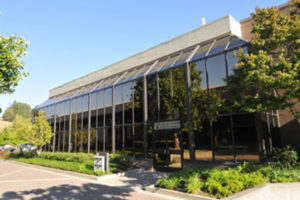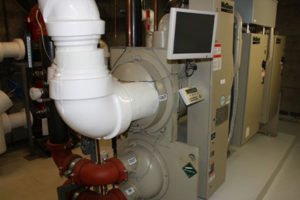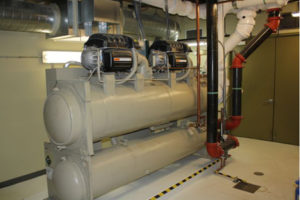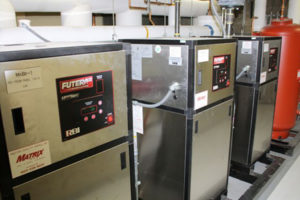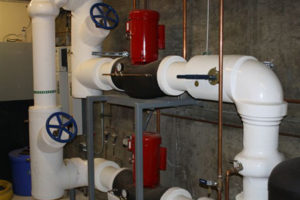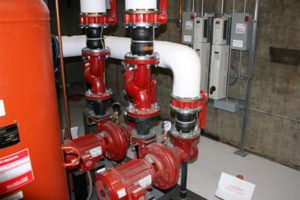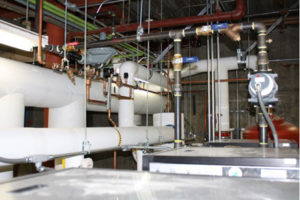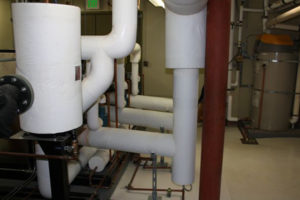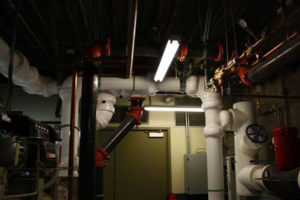HIGH-VOLTAGE SOLUTION FOR A HIGH-PROFILE PROPERTY
The Property:
As evidenced throughout our Project Spotlights, Matrix HG is privileged to work on some very high-tech and interesting properties. This property is especially unique. One of our many projects for California energy giant Pacific Gas and Electric Company (PG&E) was on the power company’s high-current testing facility in San Ramon, California. According to PG&E, the test facility can perform equipment tests up to 80,000 amps at 480 volts. There is also a high-voltage test facility that capable of performing tests up to 700kV in an environmentally-controlled condition. The highly-advanced capabilities of this facility make it the only electrical test facility of its kind west of the Mississippi.
Users of the test facilities include other electric utilities, as well as Fortune 500 companies who own their own electric distribution and/or electric transmission systems. Notably, the test facilities also have been featured on the Discovery Channel program “Myth Busters.” PG&E’s choice of Matrix HG to perform a complex retrofit of the climate-control systems in this state-of-the-art facility is a testament to Matrix’s own technical skill and ability.
The Project:
This project actually entailed two projects: Matrix was hired to design and install a new chiller system as well as a new boiler system for PG&E’s TEC Center. PG&E was experiencing mechanical problems with the existing equipment; at the same time, the power company wanted to achieve greater energy-efficiency with the new equipment.
Upon being awarded the contract, Matrix learned that not only did we present the lowest, but also the most complete bid, demonstrating our understanding of PG&E needs and expectations from these two projects.
Project Highlights
The Hurdles:
Among the design challenges posed by this project were that:
- Every step of the design had to incorporate a new design into an older building system.
- Matrix’s solution required installation of a new-technology primary variable flow system on the chilled-water side, in order to achieve PG&E’s need cost and energy efficiency.
- The boiler system had to be designed to be retrofitted in the winter over a single weekend.
Adding to these challenges were additional hurdles in the build phase:
- First, the chiller retrofit presented some surprises in the form of the weather when the job began. Outside temperatures were over 70 degrees during the month of November, meaning that we had to provide uninterrupted cooling while we completed our chiller retrofit.
- Next, we anticipated that the boiler retrofit was going to be a tough one, due to some challenges presented by the older building and existing systems that we were replacing. On top of this, during this phase of the project, we were experiencing record low temperatures.
- To make matters worse, the client had a hard deadline for the project completion. The time limitation meant that we would have only a single weekend to change out the boiler system and get it up and running.
The Matrix Solution:
- In order to meet the client’s requirements for energy and cost-efficiency, the Matrix solution called for removing an outdated York chiller and installing a McQuayâ Turbocor chiller. The chiller we selected is a new-tech design combining aerospace and industrially-proven technologies. It is both frictionless and oil-free, making it quiet, lower maintenance and environmentally-friendly.
- The warm temperatures during the chiller retrofit meant we had to bring in a temporary chiller to cool the building. We set up a rental chiller near the cooling tower over 250 feet away and piped the chiller into the underground condenser water piping. We then connected the condenser water piping inside the mechanical room to the chilled water lines coming from the building. We also connected the temporary chiller to the DDC controls to start and stop anytime there was a call for cooling.
- The existing boiler was a steam boiler. We converted the building to a hot water system. The hot water system was also converted to variable-flow.
- Matrix had to abate the existing steam boiler, install a temporary boiler to serve the load and install a new water heater for the domestic system. We had only a single weekend to shut down the temporary boiler and have the new boiler system up and running.
- To compensate for the extreme time-pressure of boiler retrofit, Matrix built the three required boiler skids in our own shop. We built the skids in pieces so that we could move them from our shop to the job site. This allowed us to perform the retrofit offsite, move the equipment to the client’s location and have the building ready for occupancy, fully up and running, on Monday!
Matrix carefully selected each of the component parts that would best fit the project requirements; then we engineered them to work in a highly-specialized way to meet the demands of this specific project and the clients’ very specialized needs. As each new challenge presented itself during the execution of the job, Matrix responded with a solution that kept the project on schedule and on-budget, while meeting our customers’ requirements for energy and cost-efficiency.

